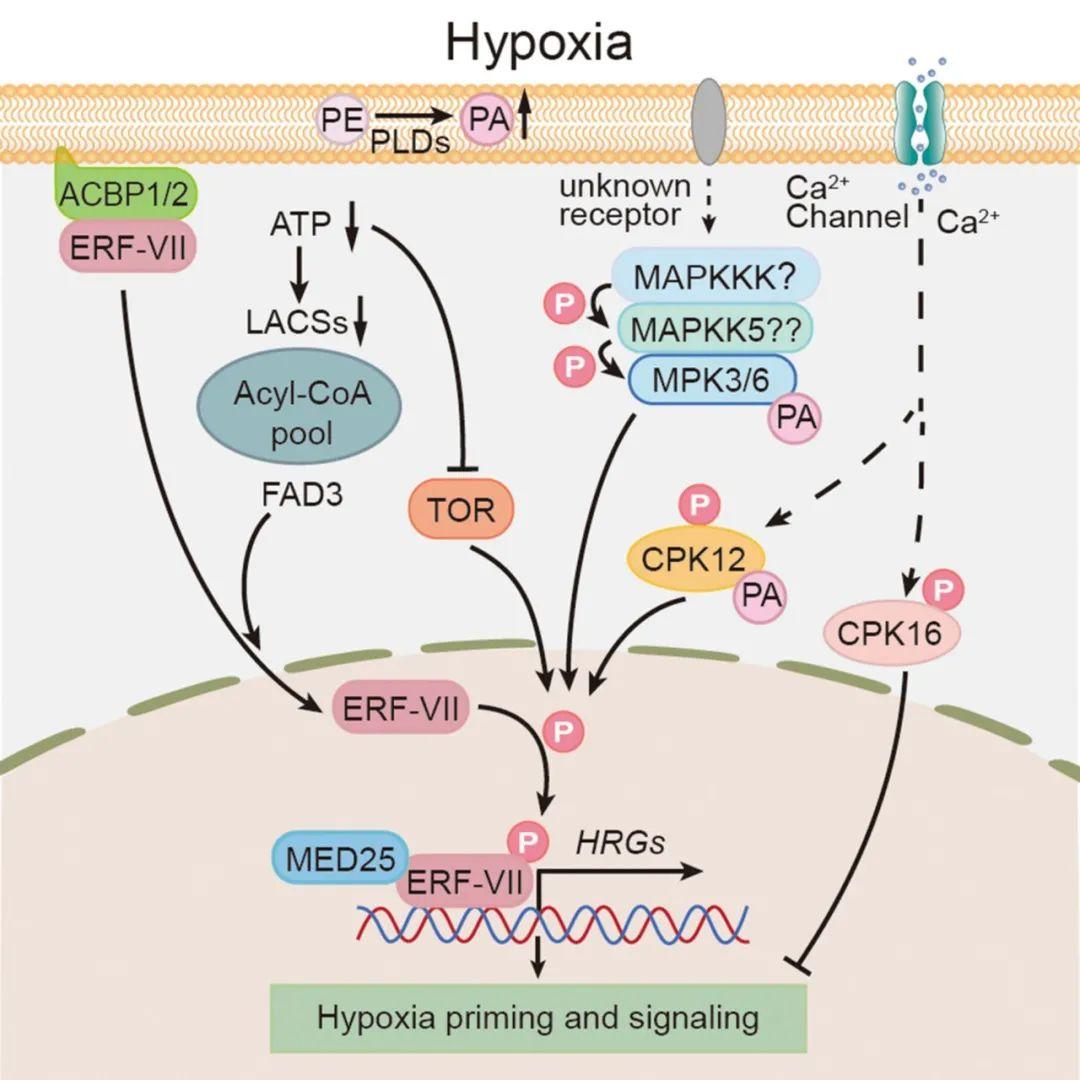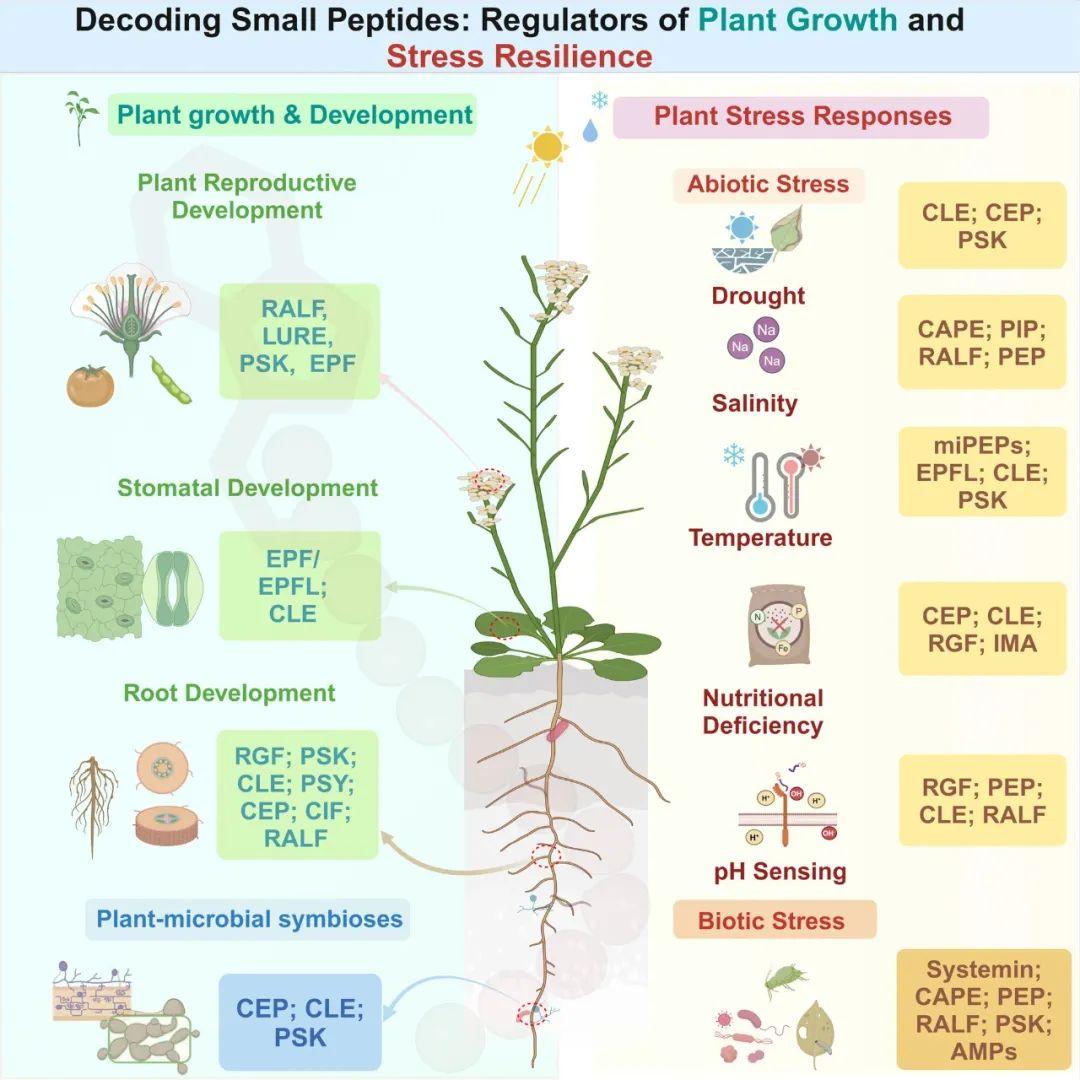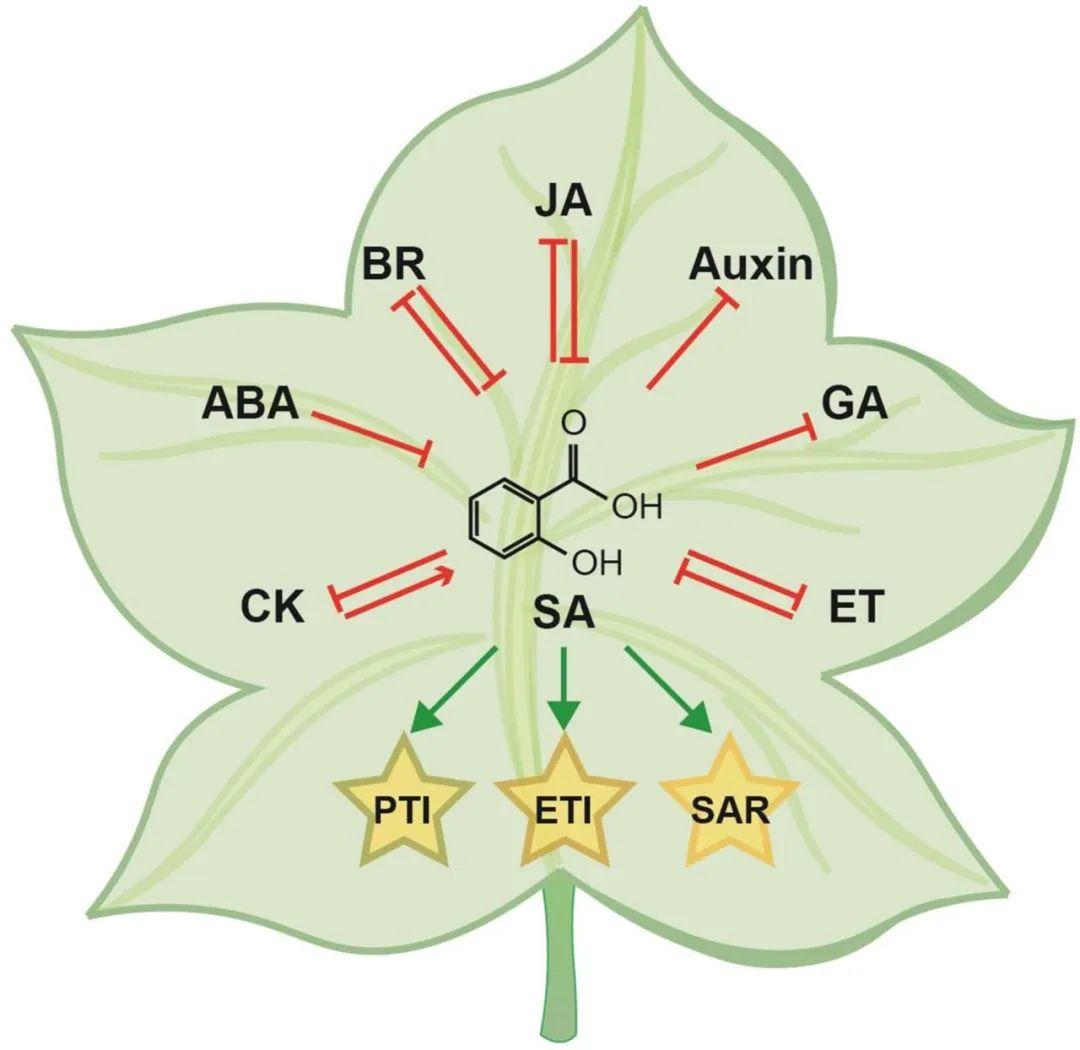

This special issue features invited expert reviews that focus on the latest progress in the fields of plant growth and development, stress resistance, functional omics, and molecular breeding. The cover centers around a vibrant “Tree of Life”, its lush canopy adorned with key research species such as apples, soybeans, tomatoes, tobacco, Arabidopsis, wheat, corn, cotton, rice, and alfalfa. Surrounding the tree are depictions of plant viruses, hormones, and chemical elements, vividly highlighting current research hotspots. Together, they present a magnificent overview of the flourishing field of plant biological science.
Mini Review
More than flowering: CONSTANS plays multifaceted roles in plant development and stress responses
Bin Yu, Yilong Hu, Xingliang Hou

This review traces research on CONSTANS (CO), from its discovery and functional studies to the exploration of its mechanisms in regulating flowering time and the circadian clock, and newly discovered functions, providing insight into the roles of CO and laying a foundation for future research.Revie
Survival mechanisms of plants under hypoxic stress: Physiological acclimation and molecular regulation
Lin-Na Wang, Wei-Cheng Wang, Ke Liao, Ling-Jing Xu, Dao-Xin Xie, Ruo-Han Xie, Shi Xiao

This review provides a summary of the regulatory network of ERF-VIIs and their post-translational regulation in plant responses to hypoxia and reoxygenation, with a particular focus on recent advancements in understanding how signaling molecules, including phytohormones, lipids, and NO, are involved in the regulation of ERV-VII activities.
The interaction of nutrient uptake with biotic and abiotic stresses in plants
Lingyan Wang, Chuanfeng Ju, Chao Han, Zhenghao Yu, Ming-Yi Bai, Cun Wang

This review explores how plants maintain nutrient uptake and use efficiency under biotic and abiotic stress, which is crucial for improving crop resilience and sustainability, and examines recent advancements in elucidating these mechanisms to guide the breeding of stress-tolerant, nutrition-efficient crop varieties for sustainable agriculture.
WRKY transcription factors: Hubs for regulating plant growth and stress responses
Lu Yang, Siyu Fang, Lei Liu, Lirong Zhao, Wanqin Chen, Xia Li, Zhiyu Xu, Shidie Chen, Houping Wang, Diqiu Yu

This review highlights the molecular regulatory mechanisms of WRKY transcription factors in balancing growth and defense responses to abiotic and biotic stresses. The dual roles of different WRKYs in growth and resistance are discussed, and the manipulation of WRKY functions is proposed to improve crop growth and stress tolerance.
Multiple roles of NAC transcription factors in plant development and stress responses
Haiyan Xiong, Haidong He, Yu Chang, Binbin Miao, Zhiwei Liu, Qianqian Wang, Faming Dong, Lizhong Xiong

This review provides an in-depth review of the structural characteristics, regulatory mechanisms, and functional roles of NAC (NAM, ATAF1/2, and CUC2) transcription factors in different plant species.
Diverse roles of MYB transcription factors in plants
Dawei Zhang, Huapeng Zhou, Yang Zhang, Yuqing Zhao, Yiyi Zhang, Xixian Feng, Honghui Lin

This review examines how MYB transcription factor family members function in: (1) the multi-level regulation of phenylpropanoid compounds, (2) the regulation of plant development from the cellular to the organ level, and (3) the regulation of plant responses and resistance to abiotic and biotic stresses.
Understanding brassinosteroid-centric phytohormone interactions for crop improvement
Wenchao Yin, Nana Dong, Xicheng Li, Yanzhao Yang, Zefu Lu, Wenbin Zhou, Qian Qian, Chengcai Chu, Hongning Tong

This review summarizes recent advances in understanding the crosstalk between brassinosteroids and other phytohormones in agronomic traits essential for crop improvement, such as those related to crop productivity and stress tolerance.
Polyamines: The valuable bio-stimulants and endogenous signaling molecules for plant development and stress response
Taibo Liu, Jing Qu, Yinyin Fang, Haishan Yang, Wenting Lai, Luyi Pan, Ji-Hong Liu

This review summarizes the diverse roles of polyamines in a variety of biological processes and illustrates the interactions between polyamines and various signaling molecules and environmental cues.
Decoding small peptides: Regulators of plant growth and stress resilience
Fei Xiao, Huapeng Zhou, Honghui Lin

This review explores how small peptides act as key regulators of plant growth, development, and stress responses. It highlights recent advances in small peptide identification and their roles in enhancing plant resilience to environmental challenges, offering new perspectives for improving crop productivity.
Cell wall dynamic changes and signaling during plant lateral root development
Erlei Shang, Qiang Tu, Zipeng Yu, Zhaojun Ding

This review provides a comprehensive overview of the dynamic cell wall changes that occur in root primordia and adjacent cells during plant lateral root development, and highlights the regulatory signals involved, with particular emphasis on the roles of phytohormones, peptides, and biotic and abiotic factors.
The comprehensive regulatory network in seed oil biosynthesis
Wei Wei, Long-Fei Wang, Jian-Jun Tao, Wan-Ke Zhang, Shou-Yi Chen, Qingxin Song, Jin-Song Zhang

This review examines the complex regulatory network governing seed oil biosynthesis, including the LAFL transcription factor network, a potential Nuclear Factor-Y regulatory network and the influences of environment factors on seed oil biosynthesis. Additionally, sugar transport, lipid metabolism, fatty acid biosynthesis inhibitors and other fine-tuning mechanisms influence oil content
Molecular breeding of tomato: Advances and challenges
Minmin Du, Chuanlong Sun, Lei Deng, Ming Zhou, Junming Li, Yongchen Du, Zhibiao Ye, Sanwen Huang, Tianlai Li, Jingquan Yu, Chang-Bao Li, Chuanyou Li

This review explores the evolution of tomato (Solanum lycopersicum) from its Andean origins to a globally cultivated crop, highlighting advancements in molecular breeding. It covers genome sequencing, functional gene identification, and CRISPR/Cas9 applications, addressing challenges in flavor, yield, and other important agrinomic traits, while envisioning future Breeding 5.0 innovations.
Big data and artificial intelligence-aided crop breeding: Progress and prospects
Wanchao Zhu, Weifu Li, Hongwei Zhang, Lin Li

Artificial intelligence technologies integrate biological big data to assist crop genetics and breeding. Intelligent precision design breeding combines biological techniques, bioinformatics, and breeding art from breeders to enhance crop breeding.
Navigating the landscape of plant proteomics
Tian Sang, Zhen Zhang, Guting Liu, Pengcheng Wang

This review highlights recent advancements in plant proteomics and explores future directions, emphasizing the potential of proteomics technologies to address fundamental questions, unlock new opportunities, and drive breakthroughs in plant biology research.
Functional genomics dissection of the nodulation autoregulation pathway (AON) in soybean (Glycine max)
Peter M. Gresshoff, Chao Su, Huanan Su, April Hastwell, Yanyan Cha, Mengbai Zhang, Estelle B. Grundy, Xitong Chu, Brett J. Ferguson, Xia Li

This review explores the history of the discovery of autoregulation of nodulation (AON) in soybean, highlighting recent advances in AON signaling pathway regulation and its interaction with processes like lateral root development, and providing new insights into understanding and further exploring the AON pathway.
Salicylic acid: The roles in plant immunity and crosstalk with other hormones
Hainan Tian, Lu Xu, Xin Li, Yuelin Zhang

This review highlights the roles of salicylic acid in plant immunity and summarizes our current understanding of the interactions of salicylic acid with other major plant hormones.
NLR-mediated antiviral immunity in plants
Min Zhu, Mingfeng Feng, Xiaorong Tao

Plant nucleotide-binding domain leucine-rich repeat receptors (NLRs) play a critical role in defending against viral infections. This review summarizes advancements in plant antiviral NLR-mediated viral effector recognition, NLR activation and regulation, downstream signaling, and the engineering of NLRs.
Spray-induced gene silencing to control plant pathogenic fungi: A step-by-step guide
Sandra Mosquera, Mireille Ginésy, Irene Teresa Bocos-Asenjo, Huma Amin, Sergio Diez-Hermano, Julio Javier Diez, Jonatan Niño-Sánchez

Spray-induced gene silencing is an innovative, eco-friendly technology for controlling plant fungal diseases by applying RNA molecules that silence key fungal genes via RNA interference. This guide explores how to develop safe and effective formulations based on current knowledge, aiming to improve their efficacy under real-world conditions.
Plant–microbiome interactions and their impacts on plant adaptation to climate change
Qing Zeng, Hang-Wei Hu, An-Hui Ge, Chao Xiong, Chang-Chun Zhai, Gui-Lan Duan, Li-Li Han, Si-Yun Huang, Li-Mei Zhang

This review summarizes how climate change factors like elevated CO2, warming, and drought affect plant microbiome assembly and function, thereby influencing plant adaptation. It highlights recent advancements, key mechanisms, and future research needs.
MicroRNA gatekeepers: Orchestrating rhizospheric dynamics
Muhammad Fahad, Leeza Tariq, Wanchang Li, Liang Wu

MicroRNAs play a crucial role in plant communication within the rhizosphere, shaping growth, development, and resilience to biotic and abiotic stresses.
